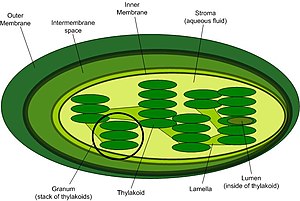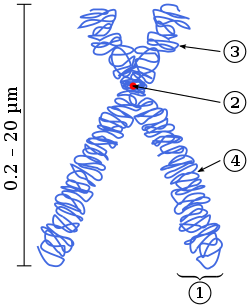Since the late 1950s and early 1960s, molecular biologists have learned to characterize, isolate, and manipulate the molecular components of cells and organisms. These components include DNA, the repository of genetic information; RNA, a close relative of DNA whose functions range from serving as a temporary working copy of DNA to actual structural and enzymatic functions as well as a functional and structural part of the translational apparatus; and proteins, the major structural and enzymatic type of molecule in cells.
For more extensive list on protein methods, see protein methods.
For more extensive list on nucleic acid methods, see nucleic acid methods.
[edit]Expression cloning
Main article: Expression cloning
One of the most basic techniques of molecular biology to study protein function is expression cloning. In this technique, DNA coding for a protein of interest is cloned (using PCR and/or restriction enzymes) into a plasmid (known as an expression vector). This plasmid may have special promoter elements to drive production of the protein of interest, and may also have antibiotic resistance markers to help follow the plasmid.
This plasmid can be inserted into either bacterial or animal cells. Introducing DNA into bacterial cells can be done by transformation (via uptake of naked DNA), conjugation (via cell-cell contact) or by transduction (via viral vector). Introducing DNA into eukaryotic cells, such as animal cells, by physical or chemical means is called transfection. Several different transfection techniques are available, such as calcium phosphate transfection,electroporation, microinjection and liposome transfection. DNA can also be introduced into eukaryotic cells using viruses or bacteria as carriers, the latter is sometimes called bactofection and in particular uses Agrobacterium tumefaciens. The plasmid may be integrated into the genome, resulting in a stable transfection, or may remain independent of the genome, called transient transfection.
In either case, DNA coding for a protein of interest is now inside a cell, and the protein can now be expressed. A variety of systems, such as inducible promoters and specific cell-signaling factors, are available to help express the protein of interest at high levels. Large quantities of a protein can then be extracted from the bacterial or eukaryotic cell. The protein can be tested for enzymatic activity under a variety of situations, the protein may be crystallized so its tertiary structure can be studied, or, in the pharmaceutical industry, the activity of new drugs against the protein can be studied.
[edit]Polymerase chain reaction (PCR)
Main article: Polymerase chain reaction
The polymerase chain reaction is an extremely versatile technique for copying DNA. In brief, PCR allows a single DNA sequence to be copied (millions of times), or altered in predetermined ways. For example, PCR can be used to introduce restriction enzyme sites, or to mutate (change) particular bases of DNA, the latter is a method referred to as "Quick change". PCR can also be used to determine whether a particular DNA fragment is found in a cDNA library. PCR has many variations, like reverse transcription PCR (RT-PCR) for amplification of RNA, and, more recently, real-time PCR (QPCR) which allow for quantitative measurement of DNA or RNA molecules.
[edit]Gel electrophoresis
Main article: Gel electrophoresis
Gel electrophoresis is one of the principal tools of molecular biology. The basic principle is that DNA, RNA, and proteins can all be separated by means of an electric field. In agarose gel electrophoresis, DNA and RNA can be separated on the basis of size by running the DNA through an agarose gel. Proteins can be separated on the basis of size by using an SDS-PAGE gel, or on the basis of size and their electric charge by using what is known as a 2D gel electrophoresis.
[edit]Southern blotting
Main article: Southern blot
Named after its inventor, biologist Edwin Southern, the Southern blot is a method for probing for the presence of a specific DNA sequence within a DNA sample. DNA samples before or after restriction enzyme digestion are separated by gel electrophoresis and then transferred to a membrane by blotting via capillary action. The membrane is then exposed to a labeled DNA probe that has a complement base sequence to the sequence on the DNA of interest. Most original protocols used radioactive labels, however non-radioactive alternatives are now available. Southern blotting is less commonly used in laboratory science due to the capacity of other techniques, such as PCR, to detect specific DNA sequences from DNA samples. These blots are still used for some applications, however, such as measuring transgene copy number intransgenic mice, or in the engineering of gene knockout embryonic stem cell lines.
[edit]Northern blotting
Main article: northern blot
The northern blot is used to study the expression patterns a specific type of RNA molecule as relative comparison among of a set of different samples of RNA. It is essentially a combination of denaturing RNA gel electrophoresis, and a blot. In this process RNA is separated based on size and is then transferred to a membrane that is then probed with a labeled complement of a sequence of interest. The results may be visualized through a variety of ways depending on the label used; however, most result in the revelation of bands representing the sizes of the RNA detected in sample. The intensity of these bands is related to the amount of the target RNA in the samples analyzed. The procedure is commonly used to study when and how much gene expression is occurring by measuring how much of that RNA is present in different samples. It is one of the most basic tools for determining at what time, and under what conditions, certain genes are expressed in living tissues.
[edit]Western blotting
Main article: western blot
Antibodies to most proteins can be created by injecting small amounts of the protein into an animal such as a mouse, rabbit, sheep, or donkey (polyclonal antibodies)or produced in cell culture (monoclonal antibodies). These antibodies can be used for a variety of analytical and preparative techniques.
In western blotting, proteins are first separated by size, in a thin gel sandwiched between two glass plates in a technique known as SDS-PAGE(sodium dodecyl sulfate polyacrylamide gel electrophoresis). The proteins in the gel are then transferred to a PVDF, nitrocellulose, nylon or other support membrane. This membrane can then be probed with solutions of antibodies. Antibodies that specifically bind to the protein of interest can then be visualized by a variety of techniques, including colored products, chemiluminescence, or autoradiography. Often, the antibodies are labeled with an enzymes. When a chemiluminescent substrate is exposed to the enzyme it allows detection. Using western blotting techniques allows not only detection but also quantitative analysis.
Analogous methods to western blotting can be used to directly stain specific proteins in live cells or tissue sections. However, theseimmunostaining methods, such as FISH, are used more often in cell biology research.
[edit]Blotting jokes
The terms "western" and "northern" are molecular biology jokes that play on the term southern blot. The first blots were with DNA, and since they were done by Ed Southern, they came to be known as Southerns. Patricia Thomas, inventor of the RNA blot, which became known as a "northern", actually didn't use the term. [2]. To carry the joke further, one can find references in the literature to "southwesterns" (protein-DNA interactions), "northwesterns" (protein-RNA interactions) and "farwesterns" (protein-protein interactions).
[edit]Arrays
Main article: DNA microarray
A DNA array is a collection of spots attached to a solid support such as a microscope slide where each spot contains one or more single-stranded DNA oligonucleotide fragment. Arrays make it possible to put down a large quantity of very small (100 micrometre diameter) spots on a single slide. Each spot has a DNA fragment molecule that is complementary to a single DNA sequence (similar to Southern blotting). A variation of this technique allows the gene expression of an organism at a particular stage in development to be qualified (expression profiling). In this technique the RNA in a tissue is isolated and converted to labeled cDNA. This cDNA is then hybridized to the fragments on the array and visualization of the hybridization can be done. Since multiple arrays can be made with the exact same position of fragments they are particularly useful for comparing the gene expression of two different tissues, such as a healthy and cancerous tissue. Also, one can measure what genes are expressed and how that expression changes with time or with other factors. For instance, the common baker's yeast,Saccharomyces cerevisiae, contains about 7000 genes; with a microarray, one can measure qualitatively how each gene is expressed, and how that expression changes, for example, with a change in temperature. There are many different ways to fabricate microarrays; the most common are silicon chips, microscope slides with spots of ~ 100 micrometre diameter, custom arrays, and arrays with larger spots on porous membranes (macroarrays). There can be anywhere from 100 spots to more than 10,000 on a given array.
Arrays can also be made with molecules other than DNA. For example, an antibody array can be used to determine what proteins or bacteriaare present in a blood sample.
[edit]Allele Specific Oligonucleotide
Allele specific oligonucleotide (ASO) is a technique that allows detection of single base mutations without the need for PCR or gel electrophoresis. Short (20-25 nucleotides in length), labeled probes are exposed to the non-fragmented target DNA. Hybridization occurs with high specificity due to the short length of the probes and even a single base change will hinder hybridization. The target DNA is then washed and the labeled probes that didn't hybridize are removed. The target DNA is then analyzed for the presence of the probe via radioactivity or fluorescence. In this experiment, as in most molecular biology techniques, a control must be used to ensure successful experimentation.
[edit]Abandoned technology
As new procedures and technology become available, the older technology is rapidly abandoned. A good example is methods for determining the size of DNA molecules. Prior to gel electrophoresis (agarose or polyacrylamide) DNA was sized with rate sedimentation in sucrose gradients, a slow and labor intensive technology requiring expensive instrumentation; prior to sucrose gradients, viscometry was used.
Aside from their historical interest, it is worth knowing about older technology as it may be useful to solve a particular problem.









